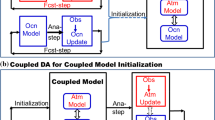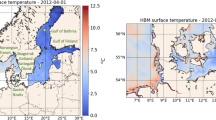Abstract
A method is proposed for removing the drift of coupled atmosphere-ocean models, which in the past has often hindered the application of coupled models in climate response and sensitivity experiments. The ocean-atmosphere flux fields exhibit inconsistencies when evaluated separately for the individual sub-systems in independent, uncoupled mode equilibrium climate computations. In order to balance these inconsistencies a constant ocean-atmosphere flux correction field is introduced in the boundary conditions coupling the two sub-systems together. The method ensures that the coupled model operates at the reference climate state for which the individual model subsystems were designed without affecting the dynamical response of the coupled system in climate variability experiments. The method is illustrated for a simple two component box model and an ocean general circulation model coupled to a two layer diagnostic atmospheric model.
Similar content being viewed by others
References
Biercamp J (1986) Interaktive Kopplung von ozeanischen Deckschichtmodellen an atmosphärische Zirkulationsmodelle. Annalen der Meteorologie (neue Folge) 23:74–75
Coakley JA (1979) A study of climate sensitivity using a simple energy balance model. J. Atm Sci 36:260–269
Gates WL, Han Y-J, Schlesinger ME (1985) The global climate simulated by a coupled atmosphere-ocean general circulation model: Preliminary results. Coupled ocean-atmosphere models, Elsevier Oceanography Series 40:131–151
Hansen J, Lacis A, Rind D, Russel D, Fung I (1984) Climate sensitivity: Analysis of feedback mechanisms. Climate processes and climate sensibility. Geophysical Monograph 29: Maurice Ewing, Vol 5, Amer Geophys Union, Washington, 130–163
Hasselmann K (1976) Stochastic climate models. Part I: Theory. Tellus 28:473–485
Hasselmann K (1982) An ocean model for climate variability studies. Prog. Oceanog 11:69–92
Hellerman S (1967) An updated estimate of the wind stress on the world ocean. Mon Wea Rev 95:606–626
Levitus S, Oort AH (1977) Global analysis of oceanogrphic data. Bull Am Met Soc 58:1270–1284
Maier-Reimer E, Hasselmann K, Olbers D, Willebrand J (1983) An ocean circulation model for climate studies. Techn Report, Max-Planck-Institut für Meterologie, Hamburg, 34 pp.
Maier-Reimer E (1985) A large scale ocean circulation model. Techn Report, Max-Planck-Institut für Meteorologie, Hamburg
Maier-Reimer E, Hasselmann K (1987) Transport and storage of CO2 in the ocean — an inorganic ocean-circulation carbon cycle model. Climate Dynamics 2:63–90.
Manabe S, Bryan K, Spelman MJ (1979) A global ocean-atmosphere climate model with seasonal variation for future studies of climate sensitivity. Dyn Atmos Oceans 3:393–426.
Manabe S, Stouffer RJ (1980) Sensitivity of a blobal climate model to an increase of CO2 concentration in the atmosphere. J Geophys Res 85 C: 5529–5554
Mitchell JFB, Lupton G (1984) A 4 × CO2 experiment with prescribed changes in sea temperatures. Progress in Biometeorology 3:353–374.
Mitchell JFB, Wilson CA, Cunnington WM (1986) On CO2 climate sensitivity and model dependence of results. Submitted for publication. (Available as DCTN 28, Dynamical Climatology Branch, Meteorological Office, Bracknell Berkshire RG12 2SZ, England)
Oort AH (1983) Global atmospheric circulation statistics, 1958–1973. NOAA Professional Paper 14: 180 pp
Sarmiento JL, Bryan K (1982) An ocean transport model for the North Atlantic. J. Geophys Res 87C:394–408
Sausen R (1986) Gekoppelte Ozean-Atmosphären-Modelle ohne Drift der prognostischen Variablen. Annalen der Meteorologie (neue Folge) 23:82–83.
Sausen R (1988) A radiative convective model including advection by prescribed winds. Meteorologisches Institut der Universität Hamburg. Large Scale Atmospheric Modelling Report
Sausen R, Barthel K, Hasselmann K (1987) A flux correction method for removing the climate drift of coupled atmosphere-ocean models. Max-Planck-Institut für Meteorologie. Hamburg, Report No. 1, 39 pp
Schlesinger ME, Gates WL, Han Y-J (1985) The role of the ocean in CO2-induced climate change: preliminary results from the OSU coupled atmosphere-ocean general circulation model. Oregon State University Climatic Research Institute. Report No 60, 35 pp
Washington WM, Semtner AJ, Meehl GA, Knight DJ, Mayer TA (1980) A general circulation experiment with a coupled atmosphere, ocean and sea ice model. J Phys Oceanogr 10:1887–1908
Author information
Authors and Affiliations
Rights and permissions
About this article
Cite this article
Sausen, R., Barthel, K. & Hasselmann, K. Coupled ocean-atmosphere models with flux correction. Climate Dynamics 2, 145–163 (1988). https://doi.org/10.1007/BF01053472
Received:
Accepted:
Issue Date:
DOI: https://doi.org/10.1007/BF01053472




